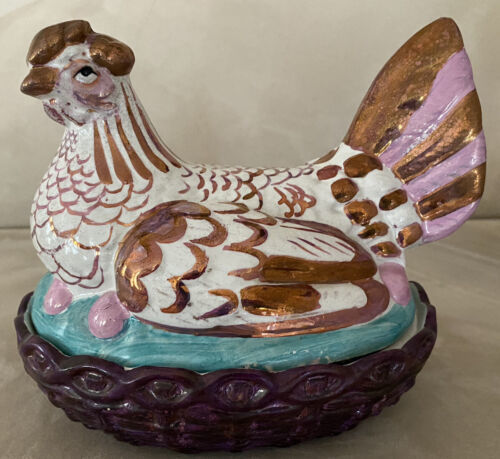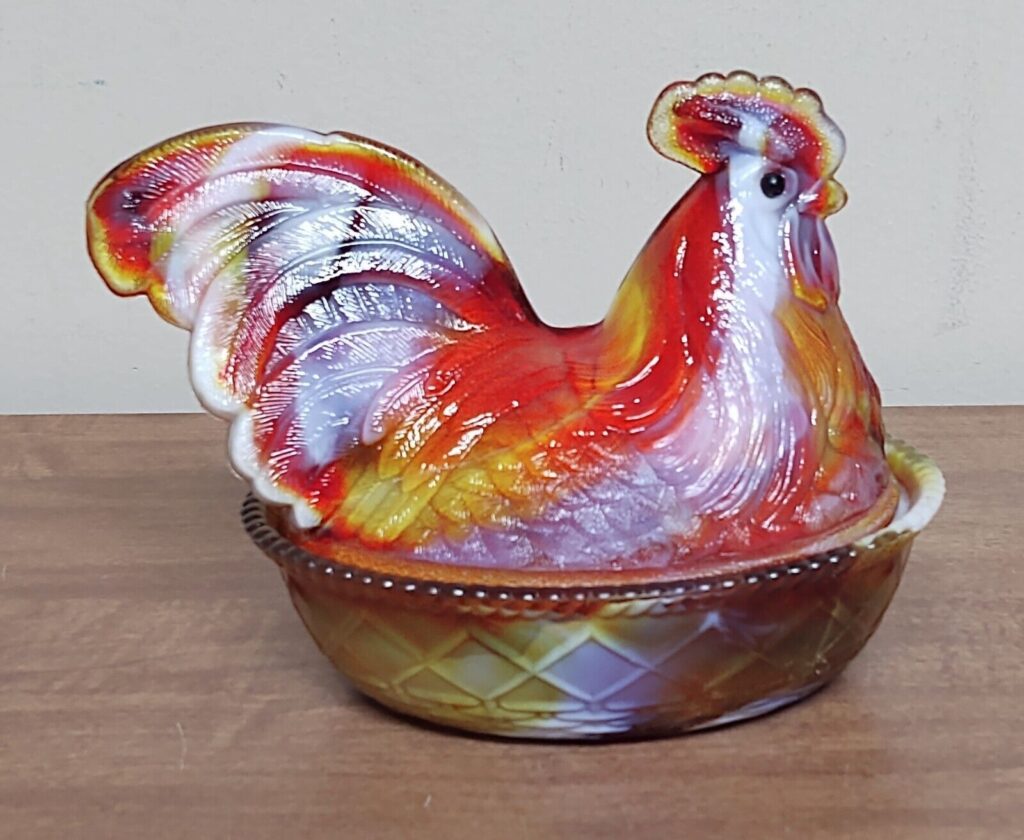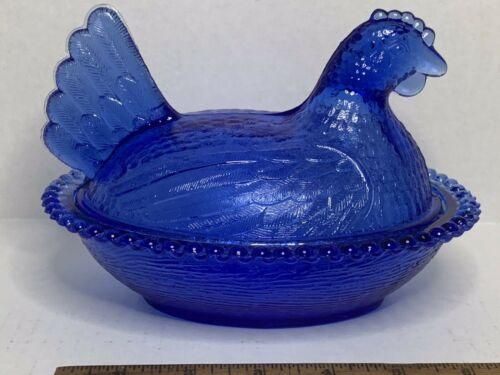#Cluck #Hen #Nest #Dishes #WorthPoint
Many people remember seeing a particular glass dish their grandmother or mother had in a china cabinet or on a table. The dish was in the form of a hen sitting on a nest, filled with candy or nuts, or used as a decorative piece.
These hen on nest covered dishes are popularly collected today for their nostalgic appeal, utilitarian purpose, and the fun of hunting for all the different varieties: hundreds of patterns and sizes have been made in various colors.
Hen on nest dishes are also worth clucking about—some pieces can fetch thousands of dollars.

A BRIEF HISTORY OF HEN DISHES
Dishes in the form of a hen laying contently on her nest, also known as animal dishes, trinket bowls, and nesting hens, originated several centuries ago in China and gained popularity in Europe during the late 18th century. These early dishes, made of stoneware pottery, were both practical, decorative, and pricey pieces that only the wealthy could afford.
The dishes were commonly made in smaller sizes, which were used as salt cellars or for storing trinkets, and larger sizes for candy, nuts, other small treats, or holding butter.

Early hen on nest dishes were made of Staffordshire pottery and are just as popular with collectors today as their glass counterparts.
Hen on nest dishes became popular in the United States after they were imported from Staffordshire, England, and other places overseas in the 19th century. After machine-made pressed glass was developed in the late 1800s, the mass production of hen dishes boomed. They were made in different colors and styles and also became more affordable. The ubiquitous hen-on-nest motif also appeared on cast-iron banks, candy molds, and other items.
In the United States, Central and Boston & Sandwich glass companies were most likely the first to produce hen on nest dishes. Around the turn of the century, Anchor-Hocking, Atterbury, Boyd, Fenton, Greentown, Indiana Glass, and many other American manufacturers also capitalized on their popularity and made their own versions of the dishes they packaged mustard and other condiments in.
These pieces didn’t get their “hen on nest” name until the 1930s when Westmoreland Glass coined the term. Collectors also refer to them as HON, chicken on nest, hen in nest, rooster on nest, and other variations.
The dishes have been made worldwide and aren’t just limited to hens. There are variations with a rooster or several chicks sitting on a nest, and deer, geese, frogs, rabbits, and other animals were also made.
Hen dishes were produced in a variety of glass, including carnival, Depression, milk, and Vaseline. The most common hens are clear glass and white milk glass examples, which often have red combs and wattles to resemble real chickens. But they were also made in a wide range of colors, including amber, amethyst, blue, green, pink, purple, and even black, and with a variety of finishes like fired-on painting, frosting, hand-painting, iridizing, and staining. There are also lead crystal pieces.

A Westmoreland slag-glass hen in fall colors would look at home on a Thanksgiving table. Westmoreland gave these dishes their name in the 1930s.
BUILDING A COLLECTION
The charming kitsch of these dishes makes them a popular collectible, and collectors have a huge variety to choose from. At least 100 glass companies are believed to have produced hen on nest dishes in more than 250 shapes and sizes over the decades that range from 2 inches or less to more than 8 inches long, though most pieces are commonly in the 5- to 7-inch range. Regardless of what sizes you collect, these dishes are easy to display and add a dash of color and whimsy to any table and shelf.
Prices range from $25 and under to thousands for some of the most rare and sought-after dishes. The highest price recorded in the WorthPoint Price Guide is $6,250 for a brown glass and bisque dish that sold in 2021. In 2023, a rare two-headed chicken dish sold for $8,100.
It can be difficult to definitively determine which company made what and the age of a piece. While some companies marked their dishes, like Westmoreland, many others didn’t; there were also mold designers who worked for more than one company, so some dishes share similarities between manufacturers.
Glass companies had individual characteristics of their pieces, such as the types of glass and colors they produced. The size of the dish is a big clue in identification, as certain companies only made specific sizes. Wetzel Glass, for example, made small hen on nest salt dips. If you can find them, company catalogs are also helpful for identifying pieces.
Be aware that reproductions have been made in pottery and iridescent colors of carnival glass, so it’s important to know the original colors from newer ones. It’s also important to carefully study pieces and make sure that the top matches the correct base.
INDIANA’S POPULAR BROOD
Though collectors seek hen dishes made by all companies, pieces by the Indiana Glass Company have remained particularly in demand. Known for its production of Depression and carnival glass, Indiana Glass was also a prolific producer of hen on nest candy dishes and was considered one of the most prominent companies that made them. Some of its pieces are also among the most valuable.
The company’s iconic seven-inch hen pretty much kept its same basic appearance from the 1930s to the late 1990s and was made in a rainbow of colors, including five in carnival glass and between 25 and 30 shades overall. Collectors find this wide array of colors appealing, especially the hunt for scarce shades, which command higher prices.
Two of the most valuable Indiana Glass hens are the mysterious and legendary cobalt blue hens and the mulberry-stained dishes. Considered Holy Grails, these examples can sell for $1,000 or more.
To learn more about these endearing pieces, a valuable resource in WorthPoint’s Library is Shirley Smith’s Hen on Nest Covered Dishes: Identification & Value Guide. The book features descriptions, colors, marks, production dates, reproductions and reissues, over 800 photos, and other helpful information.
Adina K. Francis has been a writer and editor in the antiques and collectibles field for more than 20 years. She has a bit of an obsession with the Victorians and thinks that dogs are one of life’s greatest gifts.
WorthPoint—Discover. Value. Preserve.




